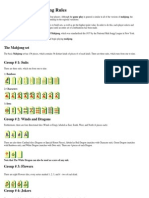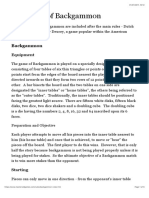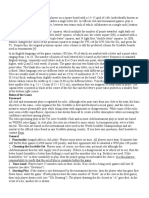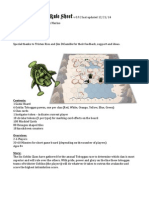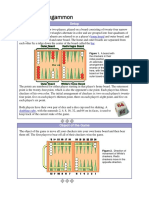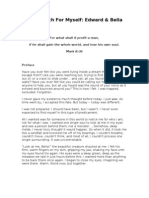Chinese Checkers Rules: Equipment
Chinese Checkers Rules: Equipment
Uploaded by
arteepu4Copyright:
Available Formats
Chinese Checkers Rules: Equipment
Chinese Checkers Rules: Equipment
Uploaded by
arteepu4Original Description:
Original Title
Copyright
Available Formats
Share this document
Did you find this document useful?
Is this content inappropriate?
Copyright:
Available Formats
Chinese Checkers Rules: Equipment
Chinese Checkers Rules: Equipment
Uploaded by
arteepu4Copyright:
Available Formats
Chinese Checkers Rules
Equipment
The Chinese Checkers board is in the shape of a six pointed star. Each point of the star is a triangle consisting of ten holes (four holes to
each side). The interior of the board is a hexagon with each side five holes long. Each triangle is a different colour and there are six sets
of ten marbles with corresponding colours.
Preparation
Chinese Checkers can be played by two, three, four or six players. Obviously, for the six player game, all marbles and triangles are used.
If there are four players, play starts in two pairs of opposing triangles and a two player game should also be played from opposing
triangles. In a three player game the marbles will start in three triangles equidistant from each other.
Each player chooses a colour and the 10 marbles of that colour are placed in the appropriately coloured triangle.
Objective
The aim of the game is to be the first to player to move all ten marbles across the board and into the triangle opposite.
Play
A toss of a coin decides who starts. Players take turns to move a single marble of their own colour. In one turn a marble may either be
simply moved into an adjacent hole OR it may make one or more hops over other marbles. Where a hopping move is made, each hop
must be over an adjacent marble and into the vacant hole directly beyond it. Each hop may be over any coloured marble including the
player's own and can proceed in any one of the six directions. After each hop, the player may either finish or, if possible and desired,
continue by hopping over another marble. Occasionally, a player will be able to move a marble all the way from the starting triangle
across the board and into the opposite triangle in one turn!
Marbles are never removed from the board. It is permitted to move a marble into any hole on the board including holes in triangles
belonging to other players. However, once a marble has reached the opposite triangle, it may not be moved out of the triangle - only
within the triangle.
Finishing
The first player to occupy all 10 destination holes is the winner.
Debate has always arisen over the situation where a player is prevented from winning because an opposing player's marble occupies one
of the holes in the destination triangle. Many game rules omit to mention this implying that it is perfectly legal to block opponents in this
dubious fashion.
Alternative Rules
The following additional rule which should be wide enough to capture all such situations: If a player is prevented from moving a marble
into a hole in the destination triangle because of the presence of an opposing marble in that hole, then instead of playing in the usual way,
the player is entitled to swap the opposing marble with that of his own marble.
Alternatively, you can just say that should one or more of the holes in the target triangle contain a marble belonging to another player, this
does not prevent a player from winning. The game is simply won when all the available points within the triangle are occupied.
___________________________________________________________________________________________________________________________
You might also like
- Mahjong Rules (House Rules)Document6 pagesMahjong Rules (House Rules)Jorge100% (5)
- MandarinDocument3 pagesMandarinazareus1986100% (1)
- Ubongo RulesDocument2 pagesUbongo RulesstuntmasterroNo ratings yet
- Science City Synopsis (THESIS)Document3 pagesScience City Synopsis (THESIS)Piyush KumarNo ratings yet
- SITXFSA005 Slideshow.v1.0Document47 pagesSITXFSA005 Slideshow.v1.0Aaryann JyswalNo ratings yet
- American Mahjong RulesDocument6 pagesAmerican Mahjong RulesKarelBRG100% (2)
- Rummikub RulesDocument2 pagesRummikub RulesJo Louise0% (1)
- The Rules of BackgammonDocument6 pagesThe Rules of Backgammonlsi12No ratings yet
- Melanoma 2016Document413 pagesMelanoma 2016Anca-Raluca Pascu100% (2)
- Application Performance Management For Microservice Applications On Kubernetes The UltimateDocument24 pagesApplication Performance Management For Microservice Applications On Kubernetes The UltimateankitnayanNo ratings yet
- ChinesecheckerDocument16 pagesChinesecheckerJERALD GABINONo ratings yet
- Die Maulwurf Company: The Digging LayersDocument2 pagesDie Maulwurf Company: The Digging LayersArvydasNo ratings yet
- ProbDocument20 pagesProbAkash SrivastavaNo ratings yet
- Screenshot 2019-12-27 at 11.33.20 PMDocument1 pageScreenshot 2019-12-27 at 11.33.20 PMHala ArarNo ratings yet
- "Dont Lose Your Marbles!" - Game RulesDocument4 pages"Dont Lose Your Marbles!" - Game RulesC.A. ChicoineNo ratings yet
- Keltis Dice enDocument2 pagesKeltis Dice enreyaliceaNo ratings yet
- Carrom Board RulesDocument2 pagesCarrom Board RulessudittasahaNo ratings yet
- # 5. 18 Holed Gebeta Cultural GameDocument20 pages# 5. 18 Holed Gebeta Cultural GameMustefa mohamedNo ratings yet
- Das Spiel UsDocument8 pagesDas Spiel UsacidusNo ratings yet
- Game MaterialsDocument2 pagesGame MaterialsGiovanni FuscoNo ratings yet
- Riichi EN PDFDocument28 pagesRiichi EN PDFMark100% (1)
- Jo Marie Ahletea D. Lamsin Neptunites 2017 - P.E 4 Report: Strategy Board Game Halma HexagramDocument3 pagesJo Marie Ahletea D. Lamsin Neptunites 2017 - P.E 4 Report: Strategy Board Game Halma HexagramimthebossNo ratings yet
- MetroenDocument4 pagesMetroenapi-268425707No ratings yet
- The Rules of CarromDocument5 pagesThe Rules of CarromSantosh GuptaNo ratings yet
- Patricia Kaye Delantar Idesarie SilladorDocument17 pagesPatricia Kaye Delantar Idesarie SilladorJoy RodallisNo ratings yet
- Rules For Japanese Mah-Jong (2012)Document28 pagesRules For Japanese Mah-Jong (2012)el_perro_rojoNo ratings yet
- Some Interesting GamesDocument2 pagesSome Interesting GamesVictor Manuel Grijalva AltamiranoNo ratings yet
- Cmps253 Project Assign1Document4 pagesCmps253 Project Assign1Fouad H HjeijNo ratings yet
- NineMensMorrisVariationsDocument4 pagesNineMensMorrisVariationsTricia Stohr-HuntNo ratings yet
- Top ItDocument4 pagesTop ItWard21No ratings yet
- Tenni S: Object of The GameDocument5 pagesTenni S: Object of The GameJailian Rhainne Delloso BretañaNo ratings yet
- Nine Man MorrisDocument1 pageNine Man MorrisDEREK STENZELNo ratings yet
- BackgammonDocument5 pagesBackgammonDominic Dalton CalingNo ratings yet
- Mancala Rules ADADocument2 pagesMancala Rules ADALex UNo ratings yet
- Backgammon ObjectiveDocument4 pagesBackgammon ObjectiveLucius PeveralNo ratings yet
- BackgammonDocument14 pagesBackgammonAndrei Zvo100% (1)
- UntitledDocument3 pagesUntitledAlegna PalenzuelaNo ratings yet
- Riichi Mahjong - Beginner's GuideDocument8 pagesRiichi Mahjong - Beginner's GuideCostobocicus100% (1)
- Kapoyning PEDocument9 pagesKapoyning PESanta-ana Jerald JuanoNo ratings yet
- Garden Croquet-1Document6 pagesGarden Croquet-1Css LeeNo ratings yet
- SCRABBLE MECHANICS 2023 v2Document2 pagesSCRABBLE MECHANICS 2023 v2MhickLuceroNo ratings yet
- The Rules of Carrom or KaromDocument4 pagesThe Rules of Carrom or KaromBhavana Surana 7ENo ratings yet
- Carcassonne Board Game Tower Expansion RulesDocument2 pagesCarcassonne Board Game Tower Expansion RulesPetar 'Grozni' Kovač100% (1)
- Scrabble Objective of The GameDocument4 pagesScrabble Objective of The GameJeh-u BayaniNo ratings yet
- Five New Games Using A Standard Checkerboard And Checkers And Two Standard DiceFrom EverandFive New Games Using A Standard Checkerboard And Checkers And Two Standard DiceNo ratings yet
- Goblin Toboggan Rule Sheet - 12-24-14Document12 pagesGoblin Toboggan Rule Sheet - 12-24-14api-257004894No ratings yet
- Leaflet 35 UrDocument2 pagesLeaflet 35 UrCraulabeshNo ratings yet
- TMP - 11235-Rules of Backgammon1685762555Document22 pagesTMP - 11235-Rules of Backgammon1685762555sparecrapNo ratings yet
- CHECKERS GAME MECHANICSDocument3 pagesCHECKERS GAME MECHANICSsindactjay007No ratings yet
- Keltis Das OrakelDocument8 pagesKeltis Das OrakelAlinNo ratings yet
- Goose Game BoardDocument1 pageGoose Game BoardLe SorciereNo ratings yet
- BackgammonDocument14 pagesBackgammonSasa RudanNo ratings yet
- RummikubDocument3 pagesRummikubodawggNo ratings yet
- Schotten-Totten English TranslationDocument4 pagesSchotten-Totten English TranslationIgor JeremicNo ratings yet
- Indoor & Outdoor Recreational GamesDocument13 pagesIndoor & Outdoor Recreational GamesSamantha FranciscoNo ratings yet
- SquashDocument1 pageSquashUmar AhmedNo ratings yet
- KotraDocument2 pagesKotrascottobearNo ratings yet
- AGArules 9 X9 BoardDocument2 pagesAGArules 9 X9 BoardLarisa IlieNo ratings yet
- Pachisi History & RulesDocument8 pagesPachisi History & RulesMallee Blue Media100% (3)
- Tennis RulesDocument3 pagesTennis Rulesapi-391225671No ratings yet
- Croquet InstructionsDocument1 pageCroquet InstructionsHenry BarnettNo ratings yet
- Tsuro RulesDocument1 pageTsuro RulesshiselasaetaNo ratings yet
- Object of The Game: A Game For 2 - 5 Players by Stefan FeldDocument4 pagesObject of The Game: A Game For 2 - 5 Players by Stefan FeldRaluca Pasquettin PescaruNo ratings yet
- SDLDocument2 pagesSDLarteepu4No ratings yet
- TPDocument161 pagesTParteepu4No ratings yet
- OscarDocument145 pagesOscararteepu4No ratings yet
- Google Wallet Research Project: Evan T. Atherton, John Cheek, and Joseph SternDocument53 pagesGoogle Wallet Research Project: Evan T. Atherton, John Cheek, and Joseph Sternarteepu4No ratings yet
- Practical Tastypie: For The Modern DjangonautDocument36 pagesPractical Tastypie: For The Modern Djangonautarteepu4No ratings yet
- Relational Cloud: A Database-as-a-Service For The CloudDocument6 pagesRelational Cloud: A Database-as-a-Service For The Cloudarteepu4No ratings yet
- Policy TeDocument1 pagePolicy Tearteepu4No ratings yet
- p1194 ElmoreDocument2 pagesp1194 Elmorearteepu4No ratings yet
- Providing Database As A ServiceDocument10 pagesProviding Database As A Servicearteepu4No ratings yet
- Olmisoft Company ProfileDocument19 pagesOlmisoft Company Profilearteepu4No ratings yet
- Relational Cloud: A Database-as-a-Service For The CloudDocument7 pagesRelational Cloud: A Database-as-a-Service For The Cloudarteepu4No ratings yet
- Achieving High Performance With Application OutsourcingDocument16 pagesAchieving High Performance With Application Outsourcingarteepu4No ratings yet
- Two Can Keep A Secret: A Distributed Architecture For Secure Database ServicesDocument14 pagesTwo Can Keep A Secret: A Distributed Architecture For Secure Database Servicesarteepu4No ratings yet
- Mydbaas: A Framework For Database-As-A-Service Monitoring: (Araujodavid, Flavio, Jose - Macedo, Franzejr) @Document6 pagesMydbaas: A Framework For Database-As-A-Service Monitoring: (Araujodavid, Flavio, Jose - Macedo, Franzejr) @arteepu4No ratings yet
- CheckersDocument2 pagesCheckersarteepu4No ratings yet
- Building Database Applications in The CloudDocument227 pagesBuilding Database Applications in The Cloudarteepu4No ratings yet
- Giant Chinese CheckersDocument2 pagesGiant Chinese Checkersarteepu4No ratings yet
- How To Help Your Child Enjoy and Succeed at Piano Lessons: by Joseph Hoffman, M.MDocument5 pagesHow To Help Your Child Enjoy and Succeed at Piano Lessons: by Joseph Hoffman, M.Marteepu4No ratings yet
- Chinese Checkers: Adapted For The Piecepack by Mark A. BiggarDocument3 pagesChinese Checkers: Adapted For The Piecepack by Mark A. Biggararteepu4No ratings yet
- Jyothi Nandikonda Supervisor: Olav TirkkonenDocument15 pagesJyothi Nandikonda Supervisor: Olav Tirkkonenarteepu4No ratings yet
- Author: Kalinga Villages in Muntinlupa, Paranaque, and Las Piñas. Her Background in Teaching Preschool andDocument23 pagesAuthor: Kalinga Villages in Muntinlupa, Paranaque, and Las Piñas. Her Background in Teaching Preschool andarteepu4No ratings yet
- The Samurai of Ancient Japan: Curtis Witcher 9-15-12 Period 2Document1 pageThe Samurai of Ancient Japan: Curtis Witcher 9-15-12 Period 2arteepu4No ratings yet
- Maintenance: DefinitionDocument4 pagesMaintenance: DefinitionElsayed MosbahNo ratings yet
- Chamod PaperDocument5 pagesChamod PaperThiranka AriyarathnaNo ratings yet
- Petition For Cancellation of Adverse ClaimDocument3 pagesPetition For Cancellation of Adverse ClaimIan TattaoNo ratings yet
- Penstock Thickness CalculationsDocument4 pagesPenstock Thickness CalculationsgmpdNo ratings yet
- 2SA1162 Datasheet en 20140301 PDFDocument3 pages2SA1162 Datasheet en 20140301 PDFWin RobinNo ratings yet
- Arts 1Document13 pagesArts 1Lance David TanNo ratings yet
- Transfer CaseDocument19 pagesTransfer CaseFátima Cristina SilvaNo ratings yet
- Fan Fiction - The Search For MyselfDocument408 pagesFan Fiction - The Search For MyselfBlueFallenAngel89% (9)
- Hai1000 UG VL740 03 UsermanualDocument246 pagesHai1000 UG VL740 03 UsermanualRobertNo ratings yet
- Elizabeth Bateson ResumeDocument1 pageElizabeth Bateson ResumeLiz BatesonNo ratings yet
- XRP ExchangesDocument2 pagesXRP ExchangesGaindesec snNo ratings yet
- Golf Course Stat Tracking WorksheetsDocument9 pagesGolf Course Stat Tracking WorksheetsSarah Jane SaidiNo ratings yet
- AwsDocument3 pagesAwsAjay Chowdary Ajay ChowdaryNo ratings yet
- Motor Protection - Types of Faults and Protection DevicesDocument35 pagesMotor Protection - Types of Faults and Protection Deviceswondu a100% (1)
- OK Done Legal Status of Business 2Document9 pagesOK Done Legal Status of Business 2soomromaliha23No ratings yet
- Trade Union-SEUSL-2Document41 pagesTrade Union-SEUSL-2dinukadamsith_287176No ratings yet
- Astroarcheology at The Borobodur TempleDocument12 pagesAstroarcheology at The Borobodur TempleUday DokrasNo ratings yet
- Daniel Jones: A Famous British PhoneticianDocument10 pagesDaniel Jones: A Famous British PhoneticianОксана КачуловаNo ratings yet
- InstructionsDocument3 pagesInstructionsolaNo ratings yet
- Master Thesis Private EquityDocument6 pagesMaster Thesis Private Equitybsend5zk100% (2)
- Sepr 1 SRSDocument2 pagesSepr 1 SRSVikrant ShimikeriNo ratings yet
- PTW - Detection EngineeringDocument79 pagesPTW - Detection Engineeringya raNo ratings yet
- Matriculation Chemistry (Hydrocarbon) AlkeneDocument98 pagesMatriculation Chemistry (Hydrocarbon) Alkeneridwan100% (4)
- Sullair Price List 2017Document134 pagesSullair Price List 2017Dev ReftechNo ratings yet
- Strategic Management of TechnologyDocument21 pagesStrategic Management of TechnologySuresh Kumar TannanNo ratings yet
- Em 45 ManualDocument4 pagesEm 45 ManualHamidNo ratings yet





